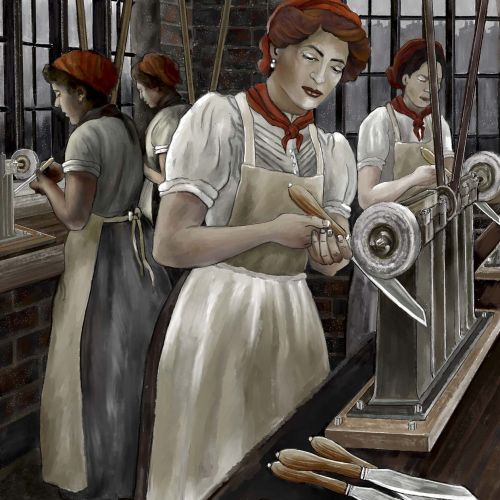Heritage artwork at the Globe Works: The Buffer
Discover the story behind the artwork

Created by Wessex Archaeology in 2022, these panels were commissioned by the Globe Works to commemorate the outstanding and unique heritage of the building and depict people and scenes from its industrial past.
Once the cutlery had been assembled, the final finishing was sent to specialists, often women, for buffing and polishing. The buffing of flatware (forks and spoons) was traditionally always done by women, whilst hollow-ware was buffed by men. It is likely the buffing of cutlery was undertaken by both men and women.
Buffing was an incredibly dirty job. The buffer girls would wear ‘buff-brats’ which comprised a white overall worn over an old dress. They also wore a triangular rag over their hair, often red in colour, and a necktie. They would also use brown paper or newspaper over the buff-brats and around their legs to catch the worst of the dirt.
The items were buffed on revolving cloth wheels using a mild abrasive of oil and sand. This work was done in ranges surrounding the main courtyard at the Globe Works, with large windows to light the workshops.
The buffer girls would often work very long hours as well as caring for a family.
Sources include:
- Unwin, J. The Development of the Cutlery and Tableware Industry in Sheffield (2002). In J. Symonds (Eds.), ARCUS Studies in Historical Archaeology 1 - The Historical Archaeology of the Sheffield Cutlery and Tableware Industry 1750-1900 (pp. 13-52).
- Unwin, J & Hawley, K. (2005) Sheffield Industries. Cutlery, Silver and Edge Tools. Tempus
- Margaret Dickinson on Sheffield’s ‘buffer girls’ - Pan Macmillan
